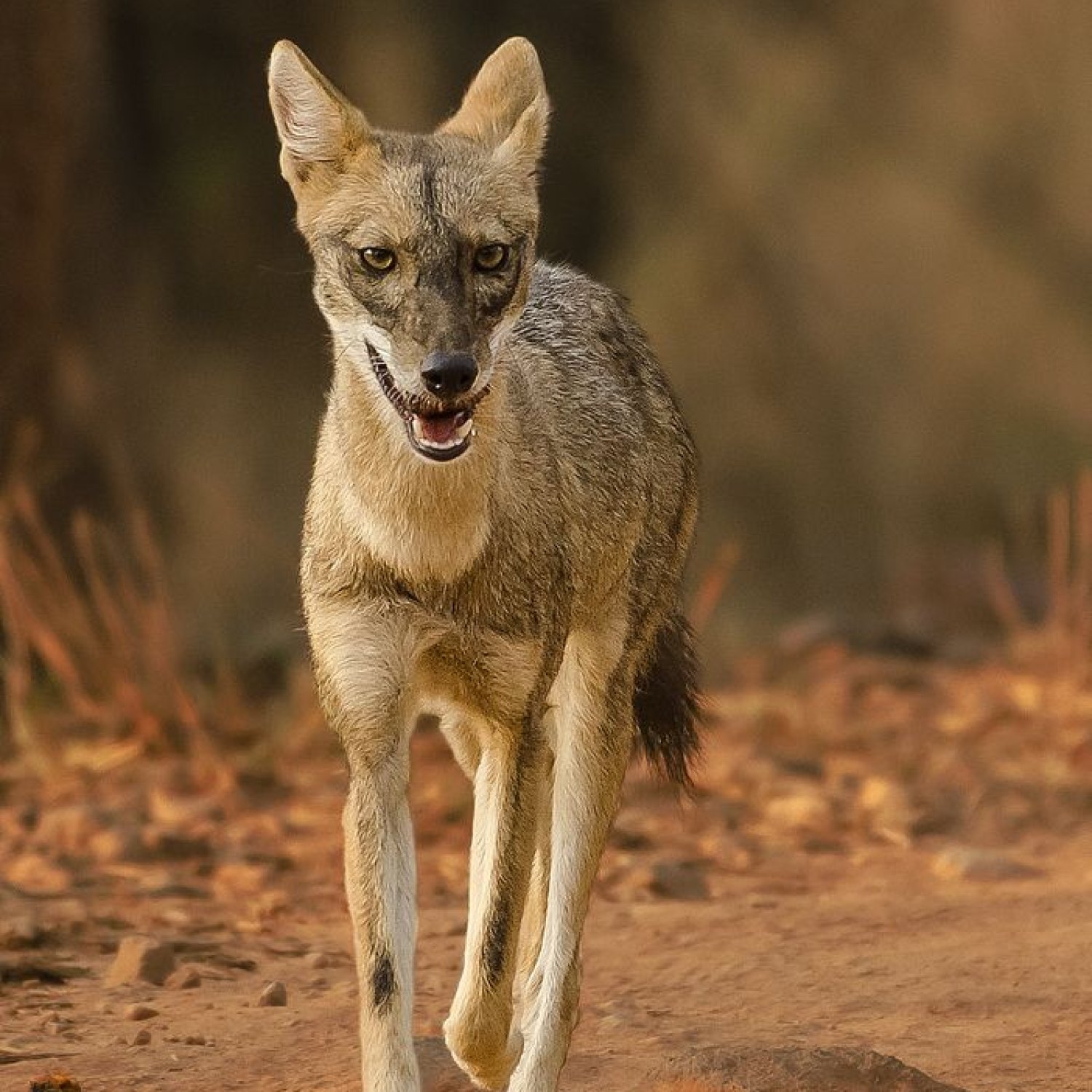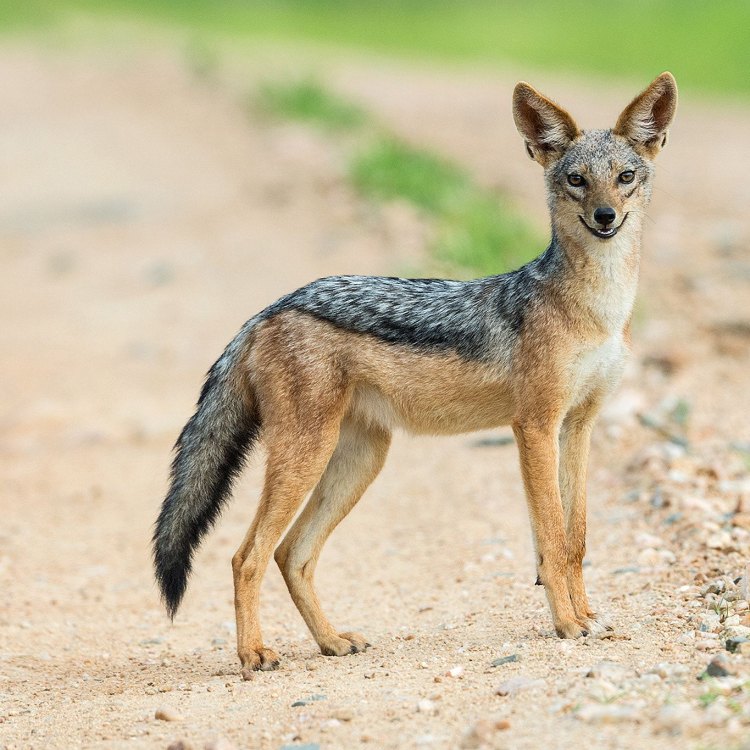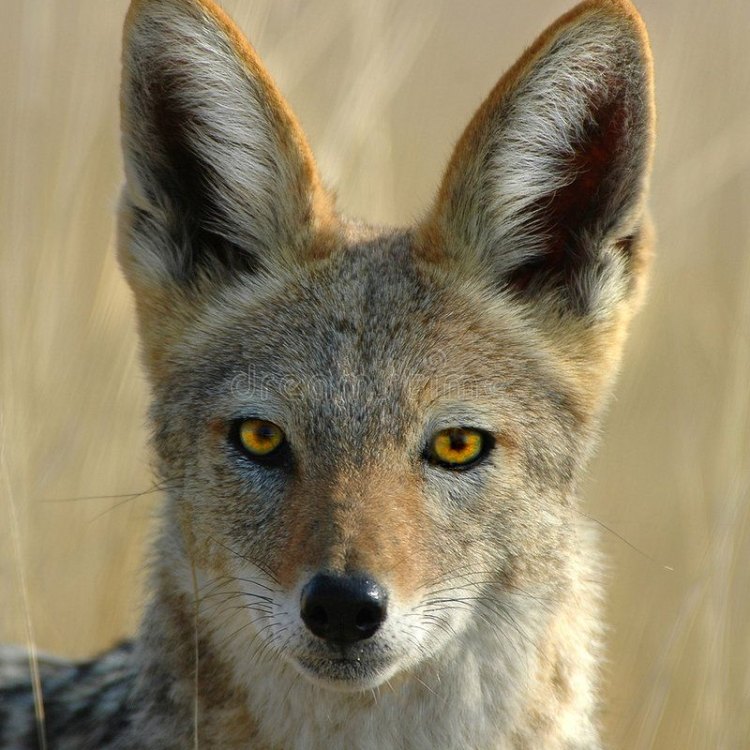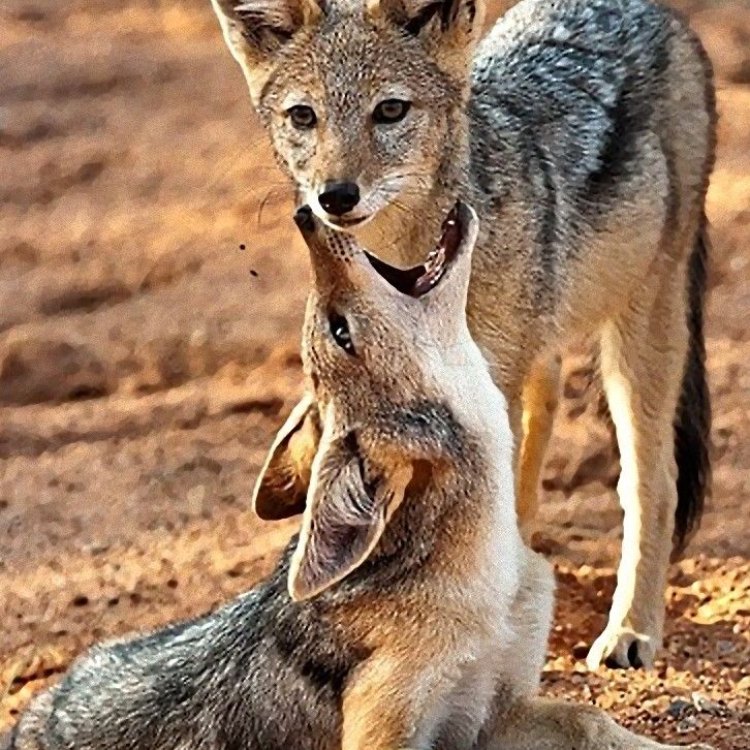
Jackal
75 to 110 cm
The jackal is a fascinating animal found in Egypt, Ethiopia, Sudan, and South Africa. With a sleek and dog-like body shape, these creatures can grow up to 110 cm. Belonging to the Canidae family, they are highly adaptable and can be spotted in various habitats. Let's learn more about these intelligent and cunning animals! #jackals #canidae #wildlife #Africa
Animal Details Summary:
Common Name: Jackal
Kingdom: Animalia
Habitat: Various habitats including deserts, savannas, and forests
The Clever and Adaptable Jackal: Surviving in Various Habitats
The jackal, also known as Canis aureus, is a fascinating and intelligent creature that has managed to survive despite the numerous changes in its environment. This small to medium-sized canine is part of the Carnivora order and Canidae family, making it a close relative of other well-known animals such as the wolf, coyote, and domestic dog.Found in multiple countries across Africa, Asia, and southeastern Europe, the jackal has proved to be a highly adaptable species, thriving in various habitats including deserts, savannas, and forests. Its ability to survive in such diverse environments and its clever and cunning nature has made it a prominent figure in folklore, literature, and even in modern-day media Jackal.
In this article, we will delve into the world of the jackal, discovering more about its physical characteristics, behavioral traits, and its vital role in the ecosystem.
Anatomy and Physical Characteristics
The jackal has a slender and dog-like body, with a height ranging from 38 to 50 cm and a length of 75 to 110 cm. Its long and narrow skull, along with its pointed ears and muzzle, give it a distinct fox-like appearance. Its fur is typically yellowish or golden-brown, with a mix of white and black on its body, giving it a camouflaged look in its natural habitat.One of the most striking features of the jackal is its piercing golden eyes, which enable it to see well at night, making it a proficient hunter. Its strong jaws and sharp teeth also aid in its hunting abilities, as it can easily tear through the flesh of its prey.
Habitat and Distribution
The jackal has a wide geographical distribution, with its origins rooted in Africa. However, over time, it has expanded its territory to include parts of Asia and southeastern Europe, where it can be found in countries like Egypt, Ethiopia, Sudan, and South Africa.One of the reasons for the jackal's successful spread to different regions is its incredible adaptability Jagdterrier. It can thrive in a range of environments, including deserts, savannas, and forests, making it a highly versatile animal. This adaptability is a result of its keen senses, high intelligence, and opportunistic feeding behavior.
Behavior and Social Structure
The jackal is a highly social animal, typically living in pairs or small family groups consisting of a monogamous mating pair and their offspring. These groups work together to defend their territory, hunt for food, and raise their young.One of the jackal's most impressive behavioral traits is its resourcefulness. It is an opportunistic feeder, meaning it will take advantage of any available food source. Its diet is diverse and varies depending on its habitat, with jackals in desert regions feeding on rodents, insects, and lizards, while those in savannas and forests eat small mammals, birds, and even fruits and vegetables.
Another notable behavior of the jackal is its cunning and clever nature. It has a highly developed sense of hearing and smell, and it can communicate with other members of its group through calls and distinct body movements. This communication helps in coordinating their hunting strategies, which often involve targeting larger prey by working together as a team.
The Jackal's Role in the Ecosystem
The jackal plays a vital role in the ecosystem, contributing to its balance and overall health. As a predator, it helps control the population of smaller animals, preventing an overabundance and potential destruction of vegetation. Its feeding behavior also aids in nutrient cycling, further contributing to a healthy environment.Moreover, jackals are scavengers, meaning they feed on the remains of animals left behind by other predators. This behavior reduces the risk of disease spread and maintains the overall cleanliness of the environment.
The Jackal in Culture and Media
The jackal has been a prominent figure in various cultures and has often been portrayed as a cunning and intelligent creature. In ancient Egyptian mythology, the god Anubis, who presided over the afterlife, was often depicted with the head of a jackal. This association was due to the jackal's frequent appearance in cemeteries and its role in scavenging on the remains of the dead.In popular media, the jackal is often portrayed as a sneaky and scheming character, known for its ability to outsmart its prey and other predators. Famous examples include the cunning jackal in Aesop's fables and the wily jackal in Rudyard Kipling's "The Jungle Book."
Conservation Status and Threats
Despite their remarkable adaptability, jackals face several threats to their environment, which have led to a decline in their population in certain regions. Loss of habitat due to human development, hunting for their fur and body parts, and conflicts with farmers due to livestock predation are among the main challenges affecting the jackal's survival.However, the jackal is not currently considered a threatened species, with its population remaining stable in many regions. Conservation efforts, such as the protection of their habitats and regulation of hunting, are crucial in maintaining their population and preventing any significant decline.
In Conclusion
The jackal is truly a fascinating and adaptable creature, able to thrive in various habitats and survive despite numerous challenges. Its intelligence, keen senses, and resourcefulness make it a formidable predator, playing a significant role in maintaining the balance of the ecosystem. However, it is essential to ensure the protection of their habitats and regulate their hunting to ensure the continued survival of this remarkable species.From its intriguing physical characteristics to its role in culture and media, the jackal is a creature that captivates the imagination and offers valuable insights into the complexity of the natural world.

Jackal
Animal Details Jackal - Scientific Name: Canis aureus
- Category: Animals J
- Scientific Name: Canis aureus
- Common Name: Jackal
- Kingdom: Animalia
- Phylum: Chordata
- Class: Mammalia
- Order: Carnivora
- Family: Canidae
- Habitat: Various habitats including deserts, savannas, and forests
- Feeding Method: Omnivorous
- Geographical Distribution: Africa, Asia, and southeastern Europe
- Country of Origin: Africa
- Location: Found in multiple countries including Egypt, Ethiopia, Sudan, and South Africa
- Animal Coloration: Typically yellowish or golden-brown
- Body Shape: Slender and dog-like
- Length: 75 to 110 cm

Jackal
- Adult Size: Medium-sized
- Average Lifespan: 8 to 10 years
- Reproduction: Sexual
- Reproductive Behavior: Monogamous
- Sound or Call: Loud howl or bark
- Migration Pattern: Non-migratory
- Social Groups: Live in small family groups
- Behavior: Nocturnal and territorial
- Threats: Habitat loss and fragmentation, hunting
- Conservation Status: Least Concern
- Impact on Ecosystem: Help control populations of small mammals
- Human Use: Hunted for their fur and body parts
- Distinctive Features: Large ears and bushy tail
- Interesting Facts: Jackals are known for their vocalizations and their ability to adapt to different habitats.
- Predator: Larger carnivores such as lions, leopards, and hyenas

Canis aureus
The Versatile Jackal: An Adaptable and Vocal Canine
In the vast and diverse world of canines, one species stands out for its adaptability, vocal abilities, and distinct features - the jackal. These medium-sized canines belong to the dog family, Canidae and are found in various habitats throughout Africa, Asia, and Southeastern Europe. While many may view them as mere scavengers or pests, the jackal's unique characteristics and crucial role in their ecosystems deserve recognition.Size and Lifespan
Jackals are medium-sized canines, with an average weight of 17-33 pounds and a body length of 15-30 inches PeaceOfAnimals.Com. They have a compact build with long legs, giving them a fox-like appearance. These agile creatures are known for their speed, reaching speeds of up to 40 miles per hour when chasing prey. Their diet is primarily composed of small mammals, birds, reptiles, and even insects.On average, jackals have a lifespan of 8-10 years in the wild. However, they can live up to 13 years in captivity. They reach sexual maturity at 1-2 years old, and females can give birth to a litter of 1-9 pups after a gestation period of 60 days.
Reproductive Behavior and Social Groups
Jackals are monogamous, with pairs remaining together for life and raising their offspring as a family unit. Usually, only the dominant pair within the group will breed, helping to maintain stable populations in their habitats.Female jackals give birth in dens, which they can either dig themselves or take over from other animals, such as aardvarks or warthogs Jungle Carpet Python. The young are born blind and helpless, relying on their parents' care for survival. As they grow, they learn essential skills from their parents, such as hunting techniques and social behaviors.
Sound and Migration Patterns
One of the most distinctive features of jackals is their loud howl or bark, which can be heard for miles. These vocalizations serve various purposes, including communication within the family group and warning other animals of their presence. Jackals are also known for their yip, which is a high-pitched call used for locating members of their group.Despite their ability to travel long distances, jackals are non-migratory. They typically stay within a particular range and defend their territory from other animals, including other jackals.
Behavior and Threats
Jackals are nocturnal creatures, meaning they are most active at night. This behavior helps them avoid competing with larger predators, such as lions and hyenas, for food and resources. During the day, they rest in their dens or in shaded areas, which they dig out themselves.Like most wild animals, jackals are also highly territorial. They mark their territory with urine and feces, as well as by rubbing their scent glands on objects such as trees and rocks. This behavior is essential for their survival as it helps prevent conflicts with other animals and ensures a steady supply of food within their territory.
Unfortunately, jackals face significant threats in the wild, including habitat loss and fragmentation due to human activities, such as agriculture and urban development. They are also hunted for their fur and body parts, which are used in traditional medicine and superstitions. As a result, the conservation status of jackals is currently listed as "Least Concern" by the International Union for Conservation of Nature (IUCN). However, continued efforts in conservation and education are necessary to ensure their survival in the wild.
Impact on Ecosystems
Despite being often viewed as pests, jackals play a crucial role in their ecosystems. As predators, they help control populations of small mammals, such as rodents and rabbits, which helps maintain balance within their habitats. They also act as scavengers, feeding on carrion and helping to reduce the spread of diseases.Jackals also have a symbiotic relationship with other animals, such as the honey badger. These two species often hunt together, with the honey badger digging out small mammals from their burrows, while the jackal waits to catch them above ground.
Human Use
Human use of jackals varies across different cultures and regions. In some areas, they are considered pests and hunted for their fur and body parts, while in other parts of their range, they are hunted for their meat. Their fur is also used for decorative purposes, such as clothing and rugs.Unfortunately, the illegal trade of jackal parts also exists, adding to the pressure on their populations in the wild. However, with proper management and regulations, sustainable use of these canines can benefit both humans and the species itself.
Distinctive Features and Interesting Facts
One cannot talk about jackals without mentioning their distinctive features, which include their large, pointed ears and bushy tails. These features not only make them easily recognizable but also serve specific purposes. Their ears, for instance, help them detect prey, while their tails act as a balancing tool when running.Here are some interesting facts about jackals:
- Jackals are known for their ability to adapt to different habitats, from deserts to forests, making them one of the most versatile canines.
- In Ancient Egyptian mythology, the god Anubis was often depicted as a jackal-headed figure, symbolizing their role as guardians of the dead.
- Jackals are skilled at digging and are known to dig up the buried eggs of other animals, such as turtles and crocodiles, to feed on them.
- Contrary to popular belief, jackals do not steal treasures or shiny objects, as depicted in some legends. They simply have a strong curiosity and may pick up and play with objects they come across.
Predators
Jackals may be skilled and adaptive predators, but they are not at the top of the food chain. Larger carnivores, such as lions, leopards, and hyenas, often prey on jackals. However, their elusive behavior, speed, and agility help them avoid becoming a meal for these larger predators.The Jackal's Versatility and Importance
In conclusion, the jackal may not receive the same attention as other canines, such as wolves and foxes, but their adaptability, vocal abilities, and unique features make them a species worth learning about. From their role in controlling populations to their ability to thrive in various habitats, jackals are an essential part of their ecosystems. As humans, we must continue to work towards ensuring their survival in the wild and appreciate their versatile and fascinating nature.

The Clever and Adaptable Jackal: Surviving in Various Habitats
Disclaimer: The content provided is for informational purposes only. We cannot guarantee the accuracy of the information on this page 100%. All information provided here may change without prior notice.












